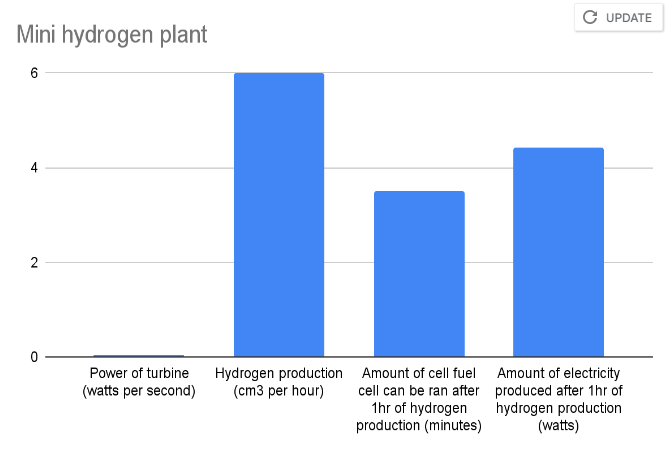Climate Detectives Projects 2022-2023
Project title: How a Hydrogen Plant could reduce emissions locally
Team: HyLite
St Muredach’s College Ballina Ireland 4 Student’s age: 16-17 years old
How a proposed windfield with attached Hydrogen Plant will benefit our local climate by providing energy with reduced emissions.
Our project was focused on exploring alternative solutions to combat climate change by investigating the potential of hydrogen plants and wind turbines as a source of clean energy. We wanted to test the power output of a hydrogen plant powered by a wind turbine, so we conducted experiments with a miniature model and compared it with a regular, full-sized turbine and hydrogen plant.
To assist with our research, we contacted Mercury Renewables, a sustainable energy company, and a postgraduate researcher associated with the project, Jochelle Ma Lois La Guipo, who provided valuable information and assistance with our queries. We believed that hydrogen plants are a promising solution for reducing carbon emissions on a large scale and can provide economic opportunities to the local community.
Our hypothesis was that green hydrogen plants, powered by renewable energy sources such as wind and solar power, could significantly reduce emissions compared to traditional fossil fuel-based hydrogen production methods. Moreover, hydrogen fuel cells, powered by this renewable hydrogen, could serve as a clean alternative to fossil fuels to power vehicles and equipment, helping to mitigate the impact of climate change.
To put our hypothesis to the test, we assembled the miniature version of the hydrogen plant and monitored the water displacement, energy output, and hydrogen production while the system ran. Safety precautions were paramount due to hydrogen’s flammable nature and its difficulty to detect in the event of a leak.
Our investigation showed that green hydrogen production using wind power can indeed be an efficient and cost-effective way of producing clean energy. Our model demonstrated that hydrogen production could be sustained through the continuous supply of wind energy to power the reversible fuel cell. The model also showed the potential for hydrogen fuel cells to serve as a clean alternative to fossil fuels for powering vehicles and equipment.

We constructed a miniature version of the windfield and hydrogen plant and collected data on its power output, hydrogen production, and other key metrics. We then compared our data to published figures for full-sized hydrogen plants, including one that was used as a benchmark for our analysis.
Our experiment found that the mini hydrogen plant produced a small amount of hydrogen at 6 cm3 per hour, with a low power output of 0.048 watts per second. The amount of time the fuel cell could run after one hour of hydrogen production was only 3.5 minutes, and the amount of electricity produced after one hour of hydrogen production was 4.41 watts.
In contrast, the large hydrogen plant produced a much larger amount of hydrogen at 71,347 cm3 per hour, which is a significant improvement over the mini plant. The power of the turbine was also much higher at 570.776 watts per second, reflecting the larger scale of the plant. The amount of time the fuel cell could run after one hour of hydrogen production was estimated at 2,497,144 minutes, and the amount of electricity produced after one hour of hydrogen production was estimated at 3,146,401.44 watts.
The comparison between the two plants does demonstrate the potential benefits of scaling up hydrogen production, as it can result in significantly larger amounts of hydrogen being produced and more electricity being generated.
Our investigation provided valuable insights into the potential of hydrogen as a source of clean energy, and a potential solution to the problem of reducing emissions while still meeting our energy needs.
Looking to the future, we believe that our investigation could be improved by conducting more extensive testing and collecting data over a longer period of time. Nonetheless, we feel that we have answered our research question and provided a strong case for the benefits of a windfield and hydrogen plant.
Projects are created by the teams and they take the full responsibility of the shared data.
← All projects



